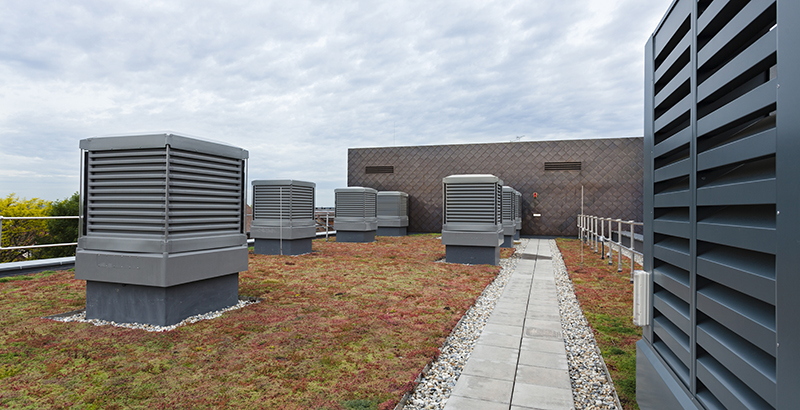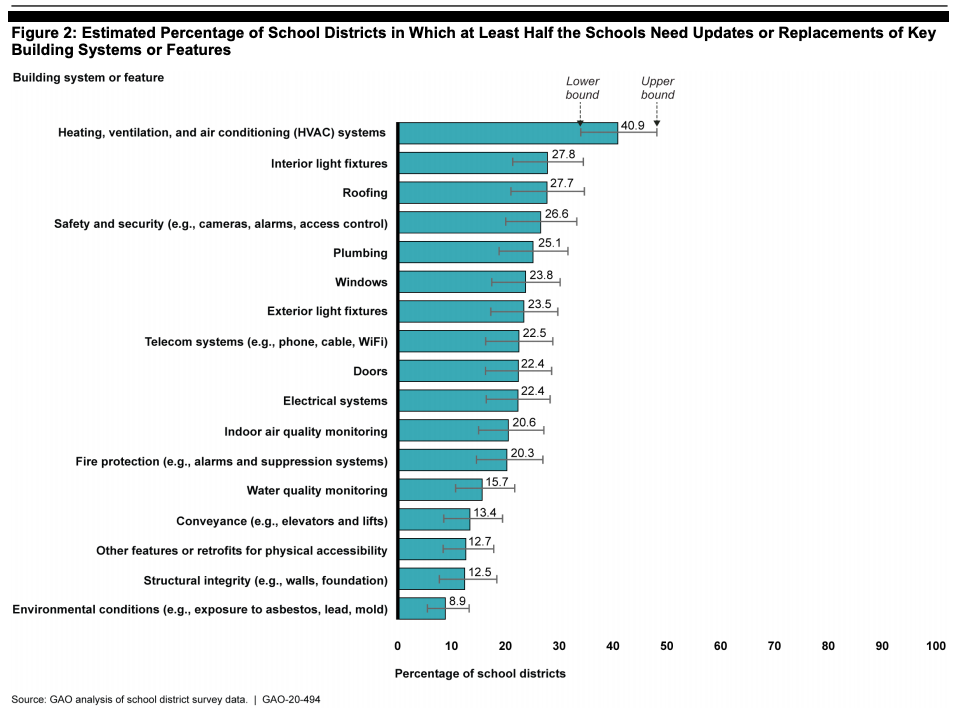The Nation’s Aging Schools Must Improve Air Quality to Prevent Covid Transmission, Experts Say. But the Price Tag Can be Daunting

Correction appended November 10
Like many districts, Massachusetts’s Framingham Public Schools is trying to determine how to safely bring back students for in-person instruction. Unlike most, this suburban district just outside Boston has a specific re-entry plan that runs 67 pages and includes a detailed survey of the ventilation system in each of its 14 schools.
Framingham is paying attention to its schools’ air quality because it wants “to help reduce the risk of contracting COVID” for staff and students, said Matthew Torti, the district’s director of building and grounds. The 9,000-student district spent $19,000 on its HVAC survey and another $340,000 on portable air filters.
Framingham has been teaching a very small percentage of its highest needs students in person, but expects to welcome 400 more students Thursday. “We’ll be ready for those students,” Torti said. Overall, the area’s transmission rates remain high, so it’s unclear when all students will transition to in-person learning.
At schools across the country, the calculus of reopening varies widely. Officials must gauge the community spread of COVID-19, state guidelines on masks and social distancing, and their ability to transport and feed children safely. But one factor is constant making sure the air is safe to breathe.
Updated guidelines from the Centers for Disease Control and Prevention last month recognized that while most people get infected by coming into close contact with someone with COVID-19, the coronavirus can be spread by airborne transmission, especially in enclosed areas with poor ventilation. It can happen even if they are more than six feet apart from an infected person or after someone with COVID has left the space, according to the agency.
Jose-Luis Jimenez, a professor of chemistry at the University of Colorado, estimates that more than a third of positive COVID transmissions occur from aerosols, not direct contact.
The importance of air quality is heightened as more districts — including, in recent weeks, Miami, Indianapolis, and Houston — head back to school. Others, such as Boston, have delayed planned returns as area infection rates have risen.
Research shows it is likely that HVAC repairs will be needed. A 2020 study from the U.S. Government Accountability Office shows 40 percent of schools need to update or replace their ventilation systems. The National Council on School Facilities estimated four years ago it would take $145 billion annually to upgrade schools to acceptable building standards, including ventilation improvements.
“The concept of deferred maintenance is commonplace in most buildings,” said Kevin Van Den Wymelenberg, an associate professor and the director of the Energy Studies Building Lab at the University of Oregon. “K-12 schools are notorious for deferred maintenance.”

For Framingham, the mission was clear: ensure its ventilation systems were operating effectively and find ways to improve air quality, Torti said. Once the district determined that its HVAC systems needed no major repairs, it upgraded filters where possible. HVAC units older than 20 years aren’t able to handle the MERV 13 filters now called for by the American Society of Heating, Refrigerating and Air-Conditioning Engineers, he added. These filters capture up to 85 percent of exhalation droplets before air is recirculated.
Torti said his office was “nailed with every sales pitch” as it decided whether additional measures were needed. The district considered using either electrical charges or UVC radiation in its HVAC system to destroy virus particles. In the end, Framingham bought enough portable air filters to place two inside most rooms.
The HEPA air filters “might be overkill, but it gives people security,” he added. The units cost $160 each and another $40 per spare filter. They are able to capture ultra fine particles from the air, but this solution may not be available to every district: Framingham budgets $19,200 per student, well above the national average.
In a sign of the constantly changing conditions schools face, Torti said one of his staffers tested positive for COVID this week, requiring the bulk of his department to self-quarantine for 14 days. The case won’t affect the district’s plan to bring kids back into schools.
Nationwide, the approach districts are taking to checking schools’ air quality varies. In Chicago, where all learning remains remote, the district is “undertaking a comprehensive assessment of every ventilation system in every school building” prior to restarting in-person learning, said Emily Bolton, the district’s director of media communications and strategy.

In New York City, school officials investigated each classroom to ensure proper ventilation before starting hybrid classes in early October. The inspections sought to identify working HVAC systems, but they also counted a classroom as having adequate ventilation if the room has a working window, an option that grows less practical as the temperature drops.
California legislators approved up to $600 million on September 30 for schools to test, adjust, repair, or replace school ventilation systems in the next three years.
While replacing a school’s HVAC system can cost up to $7 million, it is not necessary to opt for an expensive fix to improve classroom air flow. Erin Bromage, an immunologist and associate professor at the University of Massachusetts at Dartmouth, said schools could improve air quality with nothing more than a well-positioned box fan in an open window.
Understanding the science
The reason schools’ air quality is important is that it can take less than five minutes in a room where people are talking to potentially transmit the virus, according to Bromage’s online analysis. Mixing classroom air with outside air and filtering both can stop the virus from lingering and reduce the chances of transmission.
The basic standard for schools is to replace the air inside a classroom four times an hour, said Bromage, but he said schools should try to up this rate to at least six times an hour.
Corey Metzger, the founder of Resource Consulting Engineers in Ames, Iowa, said schools need to consider air exchanges, filters, and the amount of outside air introduced into a building to find the right formula. Changing air six times an hour with poor filtration and little outside air is probably worse than changing the air four times an hour with 50 percent outside air that is well filtered, he said.
Those are the best-case scenarios.
Unfortunately, a lot of schools are old and improving a filter or changing the settings to increase outside air isn’t that easy. The average school is 44 years old, according to Education Week.
“We have a lot of old schools, similar to the rest of the country,” said Scott Brown, the director of school facilities in Maine. Many of these schools simply have unit ventilators that sit in individual classrooms and recirculate classroom air. “They really need to be replaced.”
Despite that, Brown said his state has spent the last 20 years catching up on maintenance, in particular improving schools’ air quality. Even though this puts Maine ahead of the curve to improve ventilation, Brown added, “I’m on the phone all day with people trying to reassure them. It’s a tough situation. I’ve been trying for years to bring attention to air quality.”
In addition to opening windows, some Maine schools are holding classes outdoors, using tents in some cases. But with nighttime temperatures already dipping below 30 degrees in some parts of the Pine Tree State, that’s at best a temporary fix.
An official with the American Federation of Teachers said schools can also buy CO2 monitors for each room. While the buildup of carbon dioxide isn’t typically a hazard, high levels can indicate poor air circulation. Even though monitors are fairly inexpensive at about $200, having one in every classroom would quickly add up. In New York City, custodians complained that they were not trained how to use these monitors and didn’t know what constituted a dangerous CO2 level.
HVAC repairs
If schools need to replace or make major repairs on HVAC systems, they may not have the funds or the time to get work done quickly, said Mike Stangel, the executive director of facilities for the Green Bay Area Public School District in Wisconsin. Tackling his district’s needs over the last decade has left the 42-school district in good air quality shape, he added.
Right now, Green Bay is only teaching a few classes of special needs students in person, but Stangel said he’s trying to replace classroom air eight times an hour and is flushing every school with 100 percent outside air at the end of each school day.
The idea of increasing the amount of outside air in a building is antithetical to the industry’s recent attempts to cut energy costs, experts said. Outside air typically has to be either heated or cooled to maintain a comfortable environment, increasing energy consumption.
This is one area where older buildings can have an advantage, said Metzger. New buildings are made more airtight to minimize the air exchange and be energy efficient. “Old buildings breathe really well with all their cracks and leaks. That makes it easier to get away with a lot of things you can’t in a tight building.”
One concern, Van Den Wymelenberg said, is ensuring the outside air an HVAC system is pulling in is clean. When fires were raging in three states earlier this year, that wasn’t a possibility. Schools located near industrial areas can have the same problem, where the building’s HVAC filters can’t remove harmful or smelly particles.

While the experts agreed that air quality is key, Bromage was quick to point out that other factors, such as transmission rates, will also affect student safety. For schools located within areas that have low transmission rates, a school of 250 students should average about one positive COVID student every month. “That’s not a ‘close down the school’ rate,” he added. A similarly sized school in an area with high transmission rates might average one positive student for every two classrooms.
Bromage and others discouraged schools from spending lots of money on “deep cleaning,” saying the focus was misplaced. Some schools with an in-person hybrid schedule are taking one day off weekly to clean and disinfect high-touch areas such as desks and doorknobs. But “at most, surfaces are responsible for a few percentage of all infections,” Bromage said.
If schools have to pick one area to concentrate on, Van Den Wymelenberg said, it should be aerosol transmission. “Surfaces are easier to understand and less scary” than containing airborne particles. “It’s a much more complicated problem, but it is solvable.”
While the Oregon professor praised administrators for paying attention to air quality now, he rued that it took so long for most people to comprehend its importance. “We had all summer to get our schools ready, and now we’re left scrambling.”
Correction: Earlier versions of this article, including the headline, suggested it would cost $145 billion to fix school ventilation across the country. The National Council on School Facilities’ estimate actually goes beyond ventilation to include all likely upgrades required for school buildings. The article also misidentified the potential dangers of excess carbon dioxide.
Get stories like these delivered straight to your inbox. Sign up for The 74 Newsletter

;)